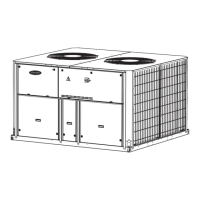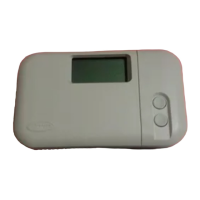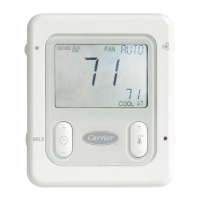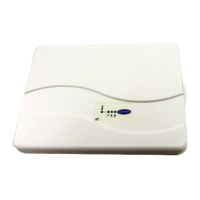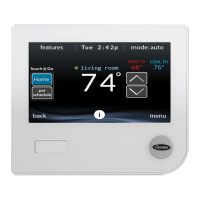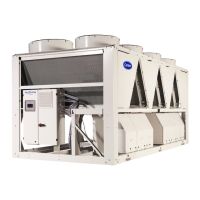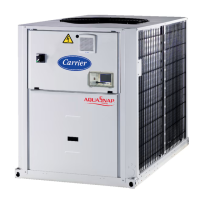13
DESCRIPTION OF OPERATING MODES (ITEM 1 OF THE INFORMATION MENU)
MODE # MODE NAME
1 Thermostat mode
2 Local mode
3 Remote control mode
4 CCN mode
5 Delay at start-up active
6 Indoor fan cycling
7 Night condensing mode
8 2nd setpoint active
9 Frost protection mode selected
10 Setpoint offset active
11 Economiser active
12 Purge active
13 Power exhaust active
14 Humidification mode active
15 Air quality control active
16 Demand limit active
17 Gas activation threshold active
18 Unit controlled by a master unit
19 Smoke detection active
20, 21 Defrost
22 High enthalpy
23 Smart start
24, 25 Low suction temperature protection
26, 27 High pressure protection
28, 29 Hot gas protection in heating mode
30, 31 Low suction temperature protection
in heating mode
32 Additional stages active
DESCRIPTION
Thermostat operating type: tStA.
Local operating type:
Off: LOFF,
On: L-On,
On in accordance with time schedule: L-Sc.
Remote control operating type: rEM.
See section 3.5. for the description of the on/off contact.
CCN network operating type: CCn.
The delay at start-up operates after the unit has been switched on. If the delay has not expired, the mode is active.
The delay is configured in the User Configuration 1 menu.
This mode is active when the indoor fan is shut down, when the setpoint is satisfied. Fan shutdown is configurable
in User Menu 1.
This function must be configured in User Configuration Menu 1. See sections 5.10 and 4.3.11.3. The night mode is
active. Fan runs at low speed (if permitted by operating conditions) and unit capacity can be limited. See section 5.9
& 4.3.11.3.
The second setpoint is active. See section 5.5.1.
Frost protection mode is active. In unoccupied periods, when the frost protection mode is selected, the unit is
completely shut down. It is only allowed to start, if: Mode 5, 6, or 7 is active, and the room temperature is below the
frost protection setpoint. The unit will remain on, until the room temperature again reaches 1.6 K above the frost
protection setpoint.
Setpoint offset is active. In this mode the unit uses the offset function to adjust the room setpoint based on the
outdoor temperature. Cooling only mode. To be activated the offset function must be configured (see section
4.3.11.3). Mode 10 is only active, when the offset value calculated by the system is other than 0.
The unitis in cooling and occupied mode and the outside temperature allows free cooling. The economiser damper
is modulated to maintain the room setpoint. The compressors are not allowed to start as the economiser damper is
not 80% open.
The unit returns to an occupied period that has to last two hours, and the outside temperature is inside the limits
defined by the user (Setpoint Menu): the economiser is kept fully open for a configurable duration (Setpoint Menu,
see section 4.3.8). To be activated, the purge function must be validated in the Configuration Menu (see section
4.3.11.3).
The power exhaust is kept fully open, as the economiser position has reached the power exhaust activation setpoint.
Humidification mode is active, as the relative humidity is inside the humidity setpoint minus the dead band, divided by
two (see section 5.19).
The economiser is modulated to maintain the room air quality at the setpoint. This function will be deactivated when it
is not possible to keep the room temperature inside acceptable limits (see section 5.16).
Demand limit is active. In this case certain unit functions are deactivated (see section 5.9). Demand limit is controlled
using a volt-free contact.
The unit is in heating mode and only authorised to operate in gas mode, as the outside temperature is inside the gas
activation threshold. Heat pumps only. See section 5.14.
The unit is part of a master/slave connection, and a difference is detected between the heating/cooling status of the
master and slave unit. In this case the slave unit is set to fan mode.
The smoke detection contact is open. All unit functions are deactivated. The indoor fan is shut down. If the unit is
equipped with an anti-fire damper, this is closed. If the unit is equipped with an economiser, this is kept 100% open.
20 = circuit A & 21 = circuit B. The unit is in heating mode, and the defrost sequence is active on the relevant circuit.
The unit is equipped with an outdoor enthalpy contact. This contact indicates an enthalpy value that does not allow
the use of the economiser.
The unit is in Smart Start mode. See section 5.5.3.
24 = circuit A & 25 = circuit B. Protection for evaporator low suction temperature circuit is active. In this mode, circuit
capacity is not authorised to rise and the circuit can be unloaded.
26 = circuit A & 27 = circuit B. The unit is in cooling mode. The circuit is in high pressure protection mode because
the HP protection threshold has been exceeded. Circuit has been unloaded and the circuit capacity is not
authorised to rise. See section 5.10.
28 = circuit A & 29 = circuit B. The unit is in heating protection mode and hot gas discharge protection is active. In
this mode, the circuit capacity cannot increase, and the circuit may be unloaded or go into defrost mode.
30 = circuit A & 31 = circuit B. The unit is in heating mode and low suction temperature protection is active. In this
mode, circuit capacity is not authorised to rise and the circuit can be unloaded or go into defrost mode.
The unit controls additional stages, and these are operating. See section 5.14.

